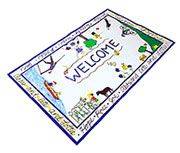Total Time Needed: 2-3 Hours
Canvas floorcloths have been around for centuries. Traditionally used to protect and decorate floors, the thick canvas rugs are attractive, as well as sturdy enough to hold up to lots of wear and tear (they clean up with a wet mop). They're also a great family project. For one thing, the rugs are inexpensive to make. While colonial floorcloths can sell for hundreds of dollars in antiques stores, you can make this one for about $30. For another, the project is easy enough for kids to do and amazingly open-ended. The blank cloth can be a canvas for just about anything a family imagines--from painted-on game boards to family portraits to bold geometric designs.
Materials
- You can purchase floorcloth canvas at canvas stores or at stores that sell or make awnings, tents, tepees or boating supplies. Check under all these subjects in your Yellow Pages and call to see if the stores sell untreated canvas, weight #10 or #12. It u
- Duct tape, staple gun, or plywood (see step 1)
- Paint brushes
- Latex paint or gesso
- Hot-glue gun (for hemming)
- Paint markers (same color as your base paint)
- Water-based clear polyurethane varnish
Instructions
1. First, determine the size of your floorcloth, then cut the canvas a few inches larger on each side to leave room for a hem. If you are making a large rug (over two or three feet), staple the canvas to a piece of plywood or--even easier--duct-tape it to a cement floor. This helps stretch the canvas and keep it flat as it dries. As you tape or staple, start at the center of each side and then move to the opposite side, stretching the material tight as you go. Secure all four sides in the center, then continue to alternate sides.
2. Put on a base by painting the canvas with two coats of latex paint, or one coat of gesso and one coat of paint. Let the surface dry thoroughly, then inspect it in a bright light to make sure you haven't left any raw canvas
3. Although many pioneer floorcloths were left unhemmed, modern versions wear better and look sleeker when the edges are hemmed or glued. To do this, first measure and mark a hem on the cloth's unpainted side
4. Cut off the tip of each corner as shown. This will ensure that, when folded, the hem corners will neatly butt up against each other, but not overlap and cause a bump.
5. With the yardstick as a guide, fold over the hem, then use a hot-glue gun to seal the edges in place.
6. Once you've determined your canvas design, rough it out with a pencil, then simply begin painting. One tip for keeping painted edges sharp (difficult to do with a brush) is to first outline the shapes with a paint marker in a color close to the one you'll be using, then fill in the outlined shape. Paint markers are particularly helpful if you'll be writing any words on the canvas. They can also help fix mistakes of splashed paint or wild brush strokes if you get one the same color as your base paint.
7. To finish your floorcloth and help it hold up to lots of dirty feet (as well as repeated moppings with soap and water), you'll need to coat it with five to six coats of clear polyurethane varnish. The water-based kind is easiest to clean up and work with, and very low-odor. Once you've varnished the cloth to a point where the surface is hard and the cloth feels thick, you are done for now, though you will want to add another coat every few years. To make the cloth stay in place on a slippery floor, use a rug mat under it or paint the back with liquid non-skid backing.
Tips:
The hardest part of making a floorcloth can be deciding what you want to paint on it. Remember, the idea here is not to create a museum showpiece but to make something that reflects your family's personality. If you have cool paints you've been wanting to experiment with, consider the possibilities of finishing your cloth with several clear coats of glitter paint to make it sparkle. Or paint over the entire thing with a coat of glow-in-the-dark paint to help people find their way back from a kitchen snack raid in the dark (both paints from Crayola Paints by Benjamin Moore).
If your best ideas inspired by other people's work, pick up a copy of The Complete Book of Floor Cloths, $25 from Lark Books (800-284-3388). The book features page after page of gorgeous floorcloths for inspiration, though keep in mind that the directions, written for seriously detail-minded crafters, can be a little intimidating.
Crafts









